155-mm Artillery Systems News
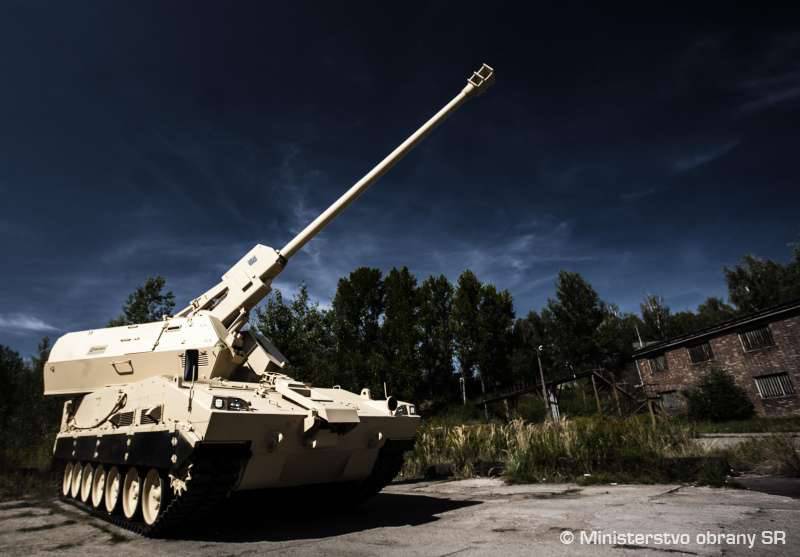
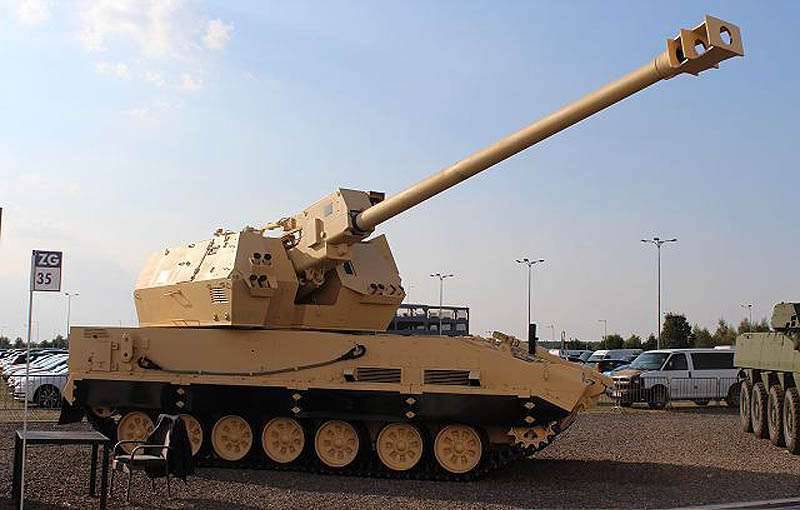
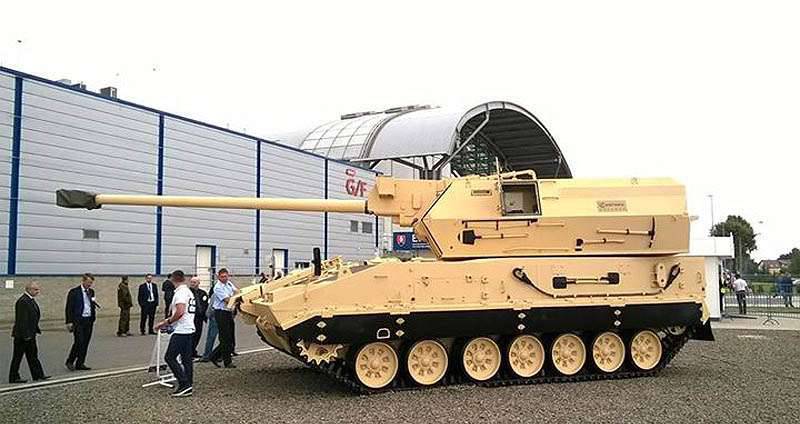
The new SAU Diana of Konstrukta is a tower with the 155 / 52 cannon of the same company Zuzana 2 installed on the upgraded chassis UPG-NG of the Polish company Bumar-Labedy
Recent developments by the United States and its allies signify the emergence of the tracked M109, a growing number of new and modernized 155-mm self-propelled artillery systems, on the market.
Nexter, on a proactive basis, developed CAESAR 155-mm howitzer (CAmion Equipé d'un System d'Artillerie - truck-mounted artillery system) with a barrel length 52 caliber (hereinafter referred to as systems, the first number of barrel caliber in millimeters, three times the barrel length in gauges, that is, in this case 155 / 52), mounted on the chassis of a truck, over the past decade has been sold in significant quantities both to the French army and to foreign customers. The French army appreciated the advantages offered by the CAESAR self-propelled howitzer (SG), in the form of better tactical mobility and survivability compared to X-TRUM X-tracked TRF155 guns, as well as better strategic mobility and lower operating costs compared to its X-NUMX-mm GCT tracked NG AUF1.
CAESAR EG can be transported by C-130 Hercules or A400M transport aircraft and has a range of 600 km fuel. The howitzer, which is in service with the French army, is based on the Sherpa 10 6x6 chassis from Renault Trucks Defense; The calculation of six people is placed in an armored cabin. The calculation dismounts to work with a howitzer, which can take a position and open fire and withdraw from a position in less than a minute.
CAESAR was first introduced in June 1994 of the year, and in September 2000 of the year, the French Department of Defense Procurement issued a contract to the company for the first five systems for assessment tests. An order for manufacturing 2004 howitzers was issued at 72, deliveries began in July 2008. For the first time, CAESAR French howitzers participated in hostilities in Afghanistan in August 2009. They were also deployed in a peacekeeping operation in Lebanon, and the CAESAR howitzer division participated in Operation Serval in Mali in the 2013-2014 years.
Nexter received in October 2013 a nine-year contract for the logistics of CAESAR military howitzers worth 133 million dollars. The French army still has a stated need for 64 systems in order to replace the remaining tracked and towed 155-mm guns, although funding has not yet been allocated.
Customers
Saudi Arabia is the largest foreign customer, having bought CAESAR howitzers installed on the chassis of the Mercedes-Benz Unimog U136 2450x6 for its National Guard 6 howitzers. Saudi systems are equipped with the Thales ATLAS fire control system, the Sagem Sigma 30 inertial navigation system, an initial velocity measurement radar, Exelis radio stations and a power management unit. Saudi Arabia also bought armor-piercing ammunition for defeating Nexter's Bonus II from above and more 60 new autonomous ballistic calculators from Nexter.
CAESAR howitzer mounted on the chassis of a Mercedes-Benz Unimog U2450 6x6
Thailand became CAESAR's first overseas customer in 2006, ordering six systems for its army; deliveries of 37 systems to Indonesia began in September 2012. The Lebanese Armed Forces will soon become the fifth operator of the CAESAR howitzer, as Saudi Arabia signed a $ 2014 billion contract with France in November 3 to supply military equipment and weapons to Lebanon, including 24 CAESAR howitzers. In early 2014, Nexter teamed up with Indian companies Larsen & Toubro and Ashok Leyland Defense to offer the Indian Army a CAESAR system mounted on Ashok Leyland Defense's Super Stallion 6x6 chassis.
The Brazilian army plans to buy a howitzer installed on a 155 / 52 self-propelled chassis as part of its strategic project Guarani, which involves purchasing up to 2044 floating armored vehicles VBTP-MR 6X6 from Iveco Latin America, as well as armored vehicles in 4XXXXX and 4 configurations In June 8, Nexter and Avibras announced that they had signed a cooperation agreement to develop a CAESAR howitzer system installed on Tatra's T8-2014 815 7 Tatra truck chassis, which is also used as a transporter for the ASTROS II Mk 6 army RSZO manufactured by Avibras . The T6 truck series includes the 6x815 configuration.
At DSEI 2015 in London, Nexter showed a CAESAR howitzer installed on Tatra T815 8x8 chassis, which has better ride quality and greater ammunition compared to the 6XXNNXX configuration option. Nexter also offers a system installed on truck chassis manufactured by Renault Trucks Defense, Rheinmetall MAN Military Vehicles and Sisu Trucks. The Tatra version has a diesel engine with an 6 horsepower, coupled with an automatic transmission, and the front four-wheel steering has a power boost.
CAESAR howitzer mounted on Tatra chassis T815 8x8
The self-propelled howitzer shown at DSEI is equipped with a three-door cab, while Nexter is developing an armored five-door cab. The CAESAR 8x8 version can carry 30 shots, 12 more than the system on the 6x6 chassis. In order to increase the stability of the platform during firing, the 8x8 version is also equipped with a hydraulically driven opener at the rear of the platform. Compared with the 6x6 mass 18 version, the 8x8 version, depending on the configuration, weighs from 28,4 to 30,2 tons. In order to increase the rate of fire and reduce crew fatigue, Nexter is developing a new semi-automatic loading system, and in the long term is considering the possibility of integrating a fully automatic loading system.
According to a review of the strategic defense and security of the British government, published on November 23 2015, new 155-mm artillery systems may be procured for the deployment of two medium “shock” brigades, formed in accordance with the new concept of the British army. Heavy armored brigades, the number of which was reduced from three to two, are armed with tracked SS AS90 155 / 39 manufactured by BAE Systems.
BAE Systems' L105 118 gun towed by BAE Systems provides fire support for an air assault rapid reaction brigade, as well as marines. The British Army has previously considered the CAESAR and 155-mm lightweight towed howitzer M777 BAE Systems as candidates for the 155-mm system with a greater degree of deployability and, most likely, they will fight for any future requirements.
New generation
The M109 crawler howitzer, which entered service with the American army in 1962, is the most common 155-mm SG, which is in service with US allies in NATO and beyond. It remains in service with more 30 countries, many of which have upgraded their systems from the original M109 and M109A1 standards.
The US Army, after two failed attempts to replace the M109 with a new 155-mm tracked system (the first XM2001 Crusader was closed in the 2002 year; the XM1203 Non-Line-of-Sight Cannon system, a member of the Future Combat Systems family of systems, was closed in the 2009 year) currently plans to leave the M109 howitzer in operation until 2050. It will perform the tasks of the main system of indirect fire support in the ABCT armored brigades (armored brigade combat team). These plans will be implemented as part of the M109A7 project, previously known under the designation M109A6 Paladin Integrated Management (PIM). This will be the most comprehensive modernization of M109, which, to the chagrin of the US military, has not yet begun. The army upgraded the old M975 howitzers to the 109 / 155 M39A109 Paladin configuration and plans to upgrade the 6 units to the new standard.
The M109A7 option is designed to resolve issues related to combat readiness in the long term and the modernization of the M109 family of machines (including the M992 transport loading machine) by creating a more reliable, tenacious and responsive fire support system from closed positions. In the version M109A7 left the main armament - 155 / 39 M284 cannon and turret, but with a newly modified layout. In order to increase the combat stability and uniformity of the ABCT armored brigades, outdated chassis and suspension components are also replaced by the corresponding subsystems from the BMN M2 / M3 Bradley.
The program is implemented in the form of a public-private partnership between the Department of Military Armored Vehicles Projects of the American Army, the Anniston Army Depot military factory and BAE Systems. In October 2013, the army issued the first contract for the initial production of the 19 howitzer M109A7 and 18 tracked transport and charging machines M992A3. The first system was delivered in April 2015. In October, 2014 Army issued a contract worth 141,8 million dollars for 18 kits, each consisting of M109A7 and M992A3. In October 2015, the army issued a contract to BAE Systems worth 245,3 million dollars for 30 kits with deliveries that will begin in June 2018. The army intends to buy 2017 kits in 37 year and increase annual purchases to 60 kits starting next year.
Elbit can install its Soltam ATMOS 155-mm howitzers with 39, 45 or 52 barrels of caliber on any suitable 6xXNNXX or 6x8 heavy truck to meet customer specific requirements.
Replacement needs
After the US Army, the Israeli armed forces are the largest operator of howitzers M109, although not all of the howitzers purchased from 600 are in operation. The artillery corps is looking for a replacement for a part of its M109 in the form of a new 155 / 52 self-propelled howitzer equipped with an automatic loader, which reduces the number of calculations and provides for the MRSI mode (multiple round simultaneous impact); several projectiles simultaneously change the angle of inclination; for a certain time interval they arrive at the target simultaneously). With the receipt of a more powerful gun, the Israeli army plans to reduce the size of its artillery divisions from 18 to 12 howitzers (division - three batteries of four howitzers).
These purchases will be partly financed from the $ 3 billion military assistance that the US government provides to Israel annually, and therefore at least part of the work will be carried out in the United States. BAE Systems, through the Israeli branch of BAE Systems, Rokar offers a solution based on the SG option M109A7. IMI has teamed up with Rheinmetall to offer an M109 upgrade with 155 / 52 trunk installation, which the German company supplied Kraz-Maffei Wegmann (KMW) for the PzH 2000 SG.
In turn, the Israeli IAI has teamed up with the KMW and Lockheed Martin companies to offer a system consisting of a KMW AGM artillery gun (Artillery Gun Module) and a Lockheed chassis (MLRS Multiple Launch Rocket System) are installed on this chassis.
Elbit Systems, which bought the Israeli artillery systems manufacturer Soltam Systems in 2010, proposes a “local spill” solution. The Autonomous Truck MOunted howitzer System (ATMOS) 2000 from Elbit Systems is a 155-TIG 2000 Soltam 39, 45 or 52 TIG gun mounted on any 6XXNNXX or 6XNNXX heavy truck selected by the manufacturer. While driving, the calculation is placed in the cabin, which provides basic protection in accordance with STANAG 8 8 level; for firing, the calculation leaves the cabin. ATMOS CG was delivered to four overseas buyers; including Thailand bought 4569 systems, which were first shipped at the end of 1 of the year.
ATMOS was reported to be the leader in the competition for the Danish army to replace the M109A3, it was ahead of the main contenders: the CAESAR howitzer and Samsung Techwin K9. Denmark wanted to buy 15 systems with more options for the 9 and 21 howitzer, but the project was canceled in April 2015. The program was re-launched in November and the local press suggested that Denmark might start cooperation with Norway, which also plans to replace its howitzers M109A3.
Both countries withdrew from the Archer 155 / 52 6x6 project by BAE Systems, leaving the Swedish army, which started the program, its only customer. After delivering four pre-production howitzers in 2013, the Swedish army received its first production system in September 2015. The installed automatic loader with a magazine on the 21 shot allows calculation to fire an Archer howitzer without leaving the armored cab.
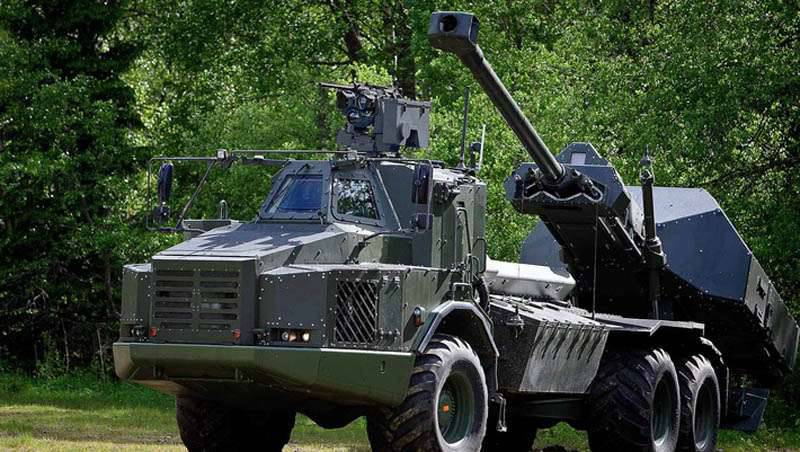
SG Archer company BAE Systems
Korean thunder
Samsung Techwin (acquired by Hanwha Group in June 2015 of the year) developed the K155 Thunder self-propelled 52 / 9 howitzer (thunder) to supplement and replace the Korean Army's M155A39 X-howitzer. At one time, this company was the lead contractor for the production of 109 howitzers M2A1040 in Korea. The first prototype XK109 was made in 2, and the first production systems in the 9 year. The Korean Army expects to have up to 1994 howitzers K1999 and 1136 K9 transport-charging machines.
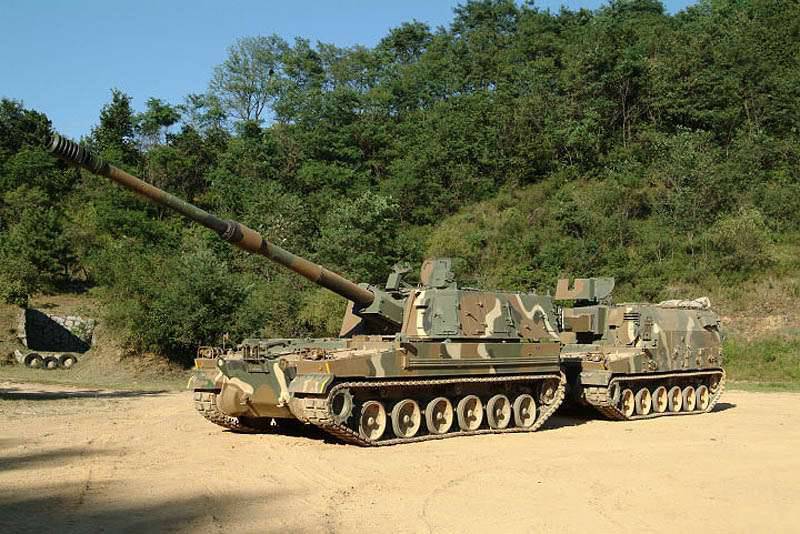
South Korean howitzer K9 with transport-loading machine K10
The calculation of this weapon system is five people; The system of automatic loading and processing of ammunition allows you to achieve a rate of three shots within 15 seconds. In the next three minutes, six to eight rounds are fired, and the rate of fire is maintained for two to three shots per minute for an hour. The K9 howitzer is equipped with an eight-cylinder diesel engine MTU MT 881 Ka-500 with horsepower 1000 hp. and hydropneumatic suspension; the mass of the system is 46 tons, the maximum speed on the highway 67 km / h and power reserve 360 km. The K10 transport-loading machine is based on the K9 chassis; it carries 100 projectiles to replenish the howitzer ammunition from 48 shots.
The K9 howitzer for the first time took part in the 23 fighting on November 2010, when six howitzer units of the Marine Corps responded with fire to the shelling by North Korean troops of Yonpyendo in the Yellow Sea.
Howitzers for export
Samsung Techwin received two large export contracts for the supply of its K9 self-propelled howitzers and is negotiating a third at the start of 2016. In 2001, the Turkish army signed a contract with Samsung for the supply of K9 howitzer subsystems for integration with local production components in Turkey, such as the fire control system (CMS) developed by Aselsan. Component shipments started in 2004, and it is estimated that more than 250 systems were manufactured.
The Turkish Armed Forces Supply Command has developed a Howitzer Ammunition Resupply Vehicle (HARV) replenishment vehicle for the K9 howitzer, in which the components of the decommissioned chassis are used to obtain an economically viable solution tanks M48. HARV carries 96 shells and 96 charges; With Aselsan’s automatic ammunition handling system, it can transfer a total of 48 rounds of ammunition to a K9 howitzer in 20 minutes. The production of the HARV transport-loading vehicle began in mid-2015, and the Turkish army plans to equip each battery of four K9 SGs with one HARV system.
In October 2015, Samsung Techwin and the Indian company Larsen & Toubro were selected to fulfill the requirements of the Indian army for the tracked SG 155/52. They are awaiting a contract with an initial value of 750-800 million dollars for the supply of 100 K9 howitzers, which will receive the local name Vajra (thunderbolt). In accordance with the plan for the modernization of the field artillery of the Indian army, published in 1999, the army intends to acquire 2820 155/52 wheeled and tracked SG, as well as towed systems for artillery regiments armament. However, to the chagrin of the applicants, who submitted their systems for numerous rounds of tests over 15 years, things did not get off the ground and the contract for the K9 howitzer will be the first contract for the serial production of a howitzer with a 155/52 barrel.
The K9 howitzer was also chosen to give impetus to the protracted Krab program of the Polish army. The project began as early as 1999, when the Polish Ministry of Defense decided to install the BAX Systems AS90 Braveheart tower, armed with an 155 / 52 L31A1 ERO cannon, on the UPG-NG tracked chassis, developed by local Bumar Łabędy. The main contractor, Huta Stalowa Wola (HSW), in May 2008 received a contract to supply the first battery of eight Krab howitzers.
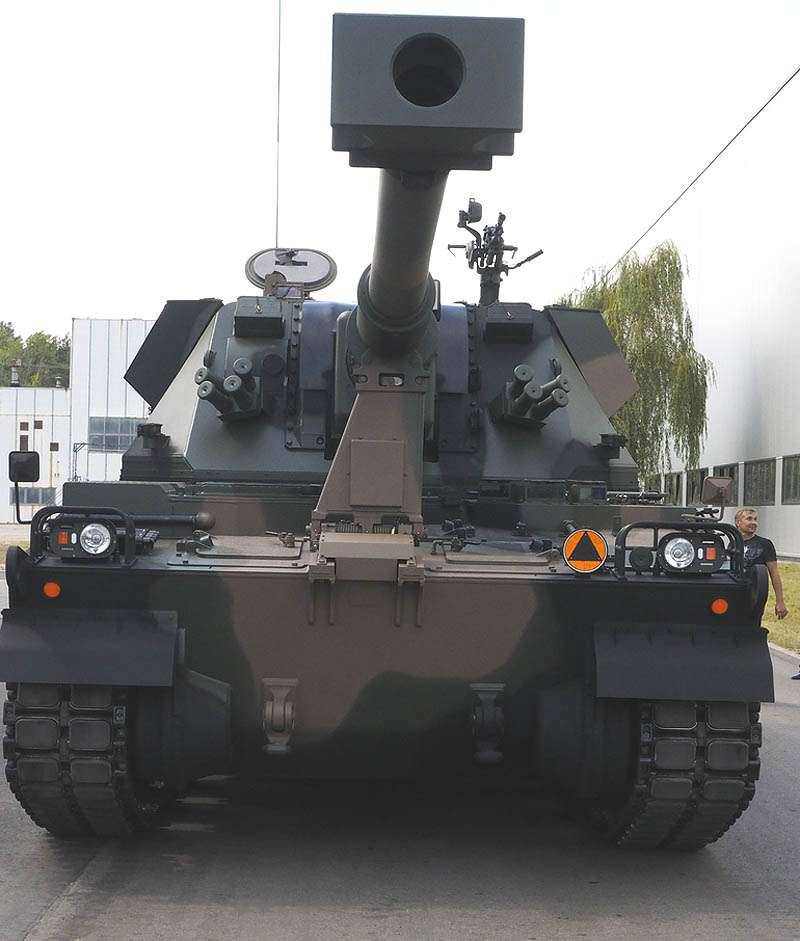
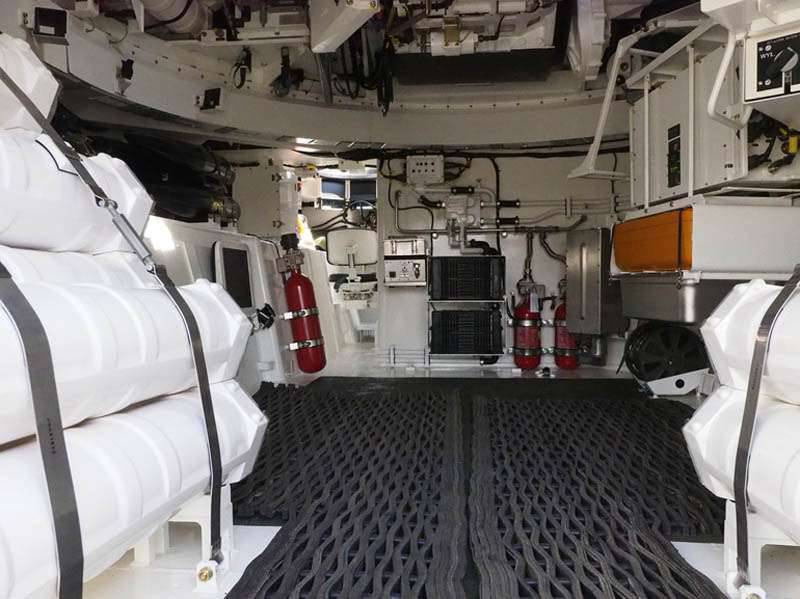
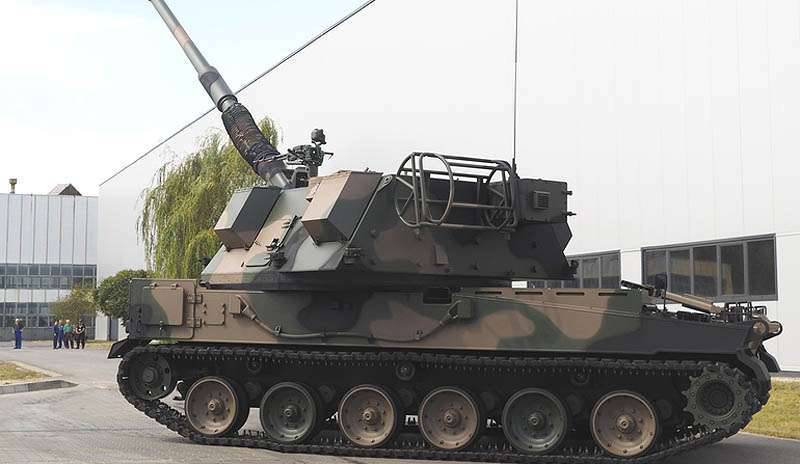
New Krab howitzer on Korean K9 chassis
After extensive testing and evaluation of the first Krab battery, carried out in 2012-2014 years and revealed problems with the chassis, the Department of Defense in December 2014 issued Samsung Techwin a contract worth 267 million dollars for the supply of 120 chassis K9. The first chassis was delivered in June 2015, and the second in September. August 24 Polish company HSW officially presented the new Krab howitzer before starting the program of extended tests and assessments, which is scheduled to be completed in the middle of 2016 year. The production systems will be armed with an Xheinmex / Xnumx Rheinmetall gun.
Samsung will supply another 22 kit and 12 partially assembled chassis, and the remaining 84 chassis will be manufactured in Poland in 2018-2022 years, with South Korea transferring all the technical documentation and technology to its howitzer. For this system, MTU will supply its MTU 881 Ka-500 engine. The Army plans to deploy Krab 120 howitzers in five battalions, each with 24 systems; The first battalion will receive its Krab SG in 2017.
BAE Systems began manufacturing howitzer M109A7 for the US Army, which plans to upgrade M580A109 6 systems to the latest standard
Polish wheels
The Polish army also wants to acquire 72 wheeled SG for equipping three battalions. At MSPO 2014, HSW showed a Kryl prototype, which is a modified 155 / 52 ATMOS 2000 cannon from Elbit Systems, mounted on the chassis of a Jelcz 663.32 6XXNNXX truck locally. Kryl tonnage 6 can be transported in a C-23 transport aircraft, has a cruising range of 130 km and a maximum speed of 500 km / h. The calculation of five people is placed in an armored cabin, and dismounts to work with the system; the system can be ready to fire and withdraw from the position in less than a minute. The Kryl howitzer has 80 rounds of ammunition and can reach the rate of fire of 18 rounds per minute. The extended tests of a recently manufactured prototype are scheduled to begin this year.
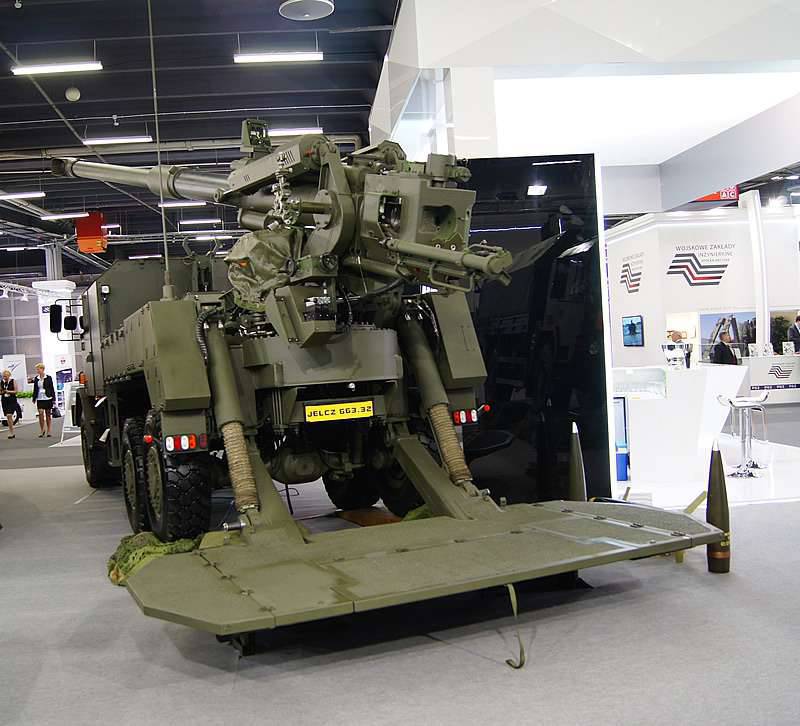
SG Kryl at MSPO 2014
The Slovak company Konsrukta Defense showed in 2015 two new self-propelled howitzers 155 / 52, which use the technology (including the gun itself) for creating howitzers Zuzana 2 8X8 of the same company. Eva SG is a magazine-powered cannon mounted on the Tatra 6x6 truck chassis, although it can also be mounted on the 8x8 chassis. The calculation of three people working with a gun while sitting in an armored cabin installed in front of the machine. In the automatic loading system, 12 shells and 12 shells are ready to fire, and 12 shells and charges are placed in the chassis. To increase stability when firing, there are hydraulically driven coulters in the rear of the machine. Eva EG can be transported in a C-130, has a power reserve of 700 km and a maximum speed of 80 km / h.
Konsrukta developed the Diana self-propelled howitzer and, in order to compete for the Indian army’s tracked SG requirements, in September 2015 showed it at MSPO. Diana is a Zuzana 2 tower mounted on the UPG-NG chassis, which was originally developed by the Polish Bumar Łabędy for the Polish Krab howitzer. Konsrukta chose a chassis that uses many components (including the power unit) from the Russian T-72 tank, as this might be of interest to the Indian army, since it has T-72 tanks in service.
The original UPG-NG chassis was upgraded to eliminate problems encountered during the Krab SG tests. The turret is equipped with an inertial navigation system and a radar for measuring the initial velocity of the projectile, as well as a television camera, a thermal imager, and a laser rangefinder for direct fire. In the Diana howitzer turret, 40 of finished projectiles and charges are placed, and another 40 is placed in the turret. SG Diana has a mass of 50 tons, a power reserve of 650 km and a maximum speed of 60 km / h.
German metal
The KMW company developed its Panzerhaubitze 2000 howitzer (PzH 2000) in the middle of the 80-ies in order to replace the out-of-date systems M109 of the German army. Deliveries of the 185 SG PzH 2000 passed in the 1998-2002 years, and the German army became the first army to receive the 155 / 52 system. Orders from other countries Greece (24), Italy (70, of which local-made 68) and the Netherlands (57) increased the number of systems produced to more than 330 units. SG PzH 2000 participated in the fighting in Afghanistan as part of the Dutch and German contingents.
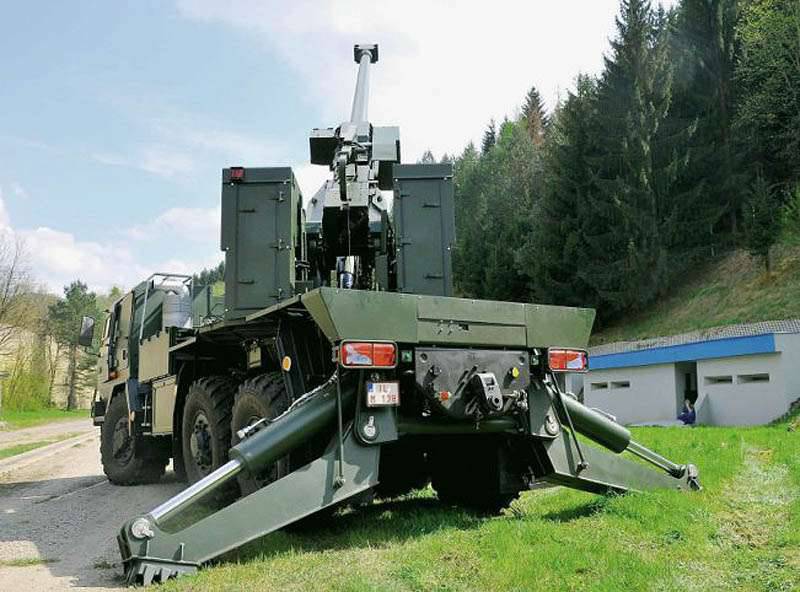
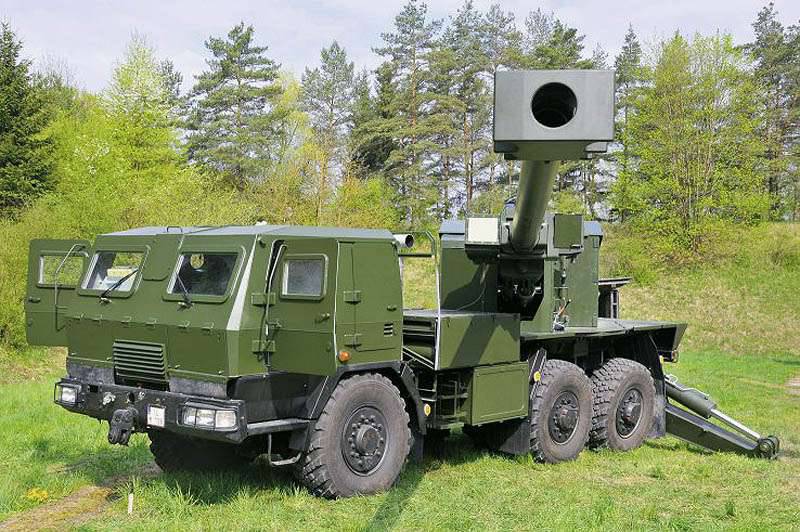
The new Konstrukta Eva 155 / 52 SG has a shop supply system for ammunition and is serviced by three people.
The calculation of howitzers is five people, and the high level of automation allows PzH 2000 to shoot a line of three shells in 9 seconds and 10 shells in 56 seconds. In this howitzer weighing 55 tons, a diesel engine MTU MT881 Ka-500 is installed, allowing you to develop 60 km / h speed on the highway and have a cruising range of 420 km. In December, 2013, the company Raytheon and the German army completed a compatibility check with the M982 Excalibur guided artillery. SG PzH 2000 shot ten Excalibur shells at a distance of 9-48 km with an average circular deviation of three meters.
In July, 2015, Croatia received the first PzH 2000 howitzer from 12, purchased from the presence of the German army in December 2014, for 13,1 million dollars. In September, 2015, Lithuania bought the 21 system also from Germany’s stockpiles. 16 howitzers will be used in daily use, one for firing practice, one for driving training, and three for replacement parts. These weapons systems will be delivered in 2016-2019 years.
German self-propelled howitzer PzH 2000
PzH 2000 howitzer production was resumed after receiving an order from Qatar for new installations in 2013. SG demonstrated its ability to shoot 155-mm projectile M2005A1 Assegai type VLAP (Velocity-enhanced Long-range Artillery Projectile - long-range artillery projectile with increased speed) manufactured by Rheinmetall Denel Munition at 56 km distance. Qatar has funded the qualification tests of the VLAP and the Rheinmetall Nitrochemie DM92 charging module for firing a PzH 2000 howitzer. The "Fresh" SG PzH 2000 was first shown 18 on December 2015 of the year at a parade in honor of Qatar National Day.
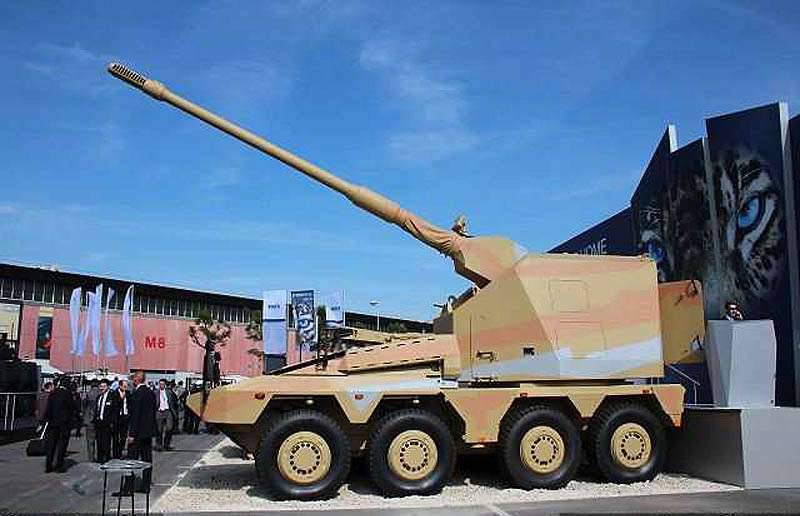
AGM module mounted on Boxer 8x8 multipurpose armored vehicle
KMW developed the AGM artillery module as an initiative in order to get a lighter system with the same fire power as the PzH 2000 howitzer. The AGM module can be installed on various wheeled and tracked chassis, on a trailer, and also permanently for the protection of important objects, such as operational bases. The AGM weighs 12 tons, it houses 30 155-mm projectiles and charges. At Eurosatory 2014, KMW showed the AGM module installed on ARTEC's multi-purpose armored Boxer 8x8. The AGM module is also offered on the new tracked chassis developed by General Dynamics European Land Systems-Santa Barbara Sistemas; this system was designated as Donar. A weapon system can be transported in an A400M transport aircraft. KMW believes that AGM and Donar will be interesting for buyers looking to replace their M109 howitzers.
Materials used:
www.kotadef.sk
www.nexter-group.fr
www.lockheedmartin.com
www.elbitsystems.com
www.hanwhatechwin.com
www.kmweg.com
www.bumar.gliwice.pl
www.rheinmetall.com
www.gdls.com
www.baesystems.com
www.wikipedia.org
en.wikipedia.org
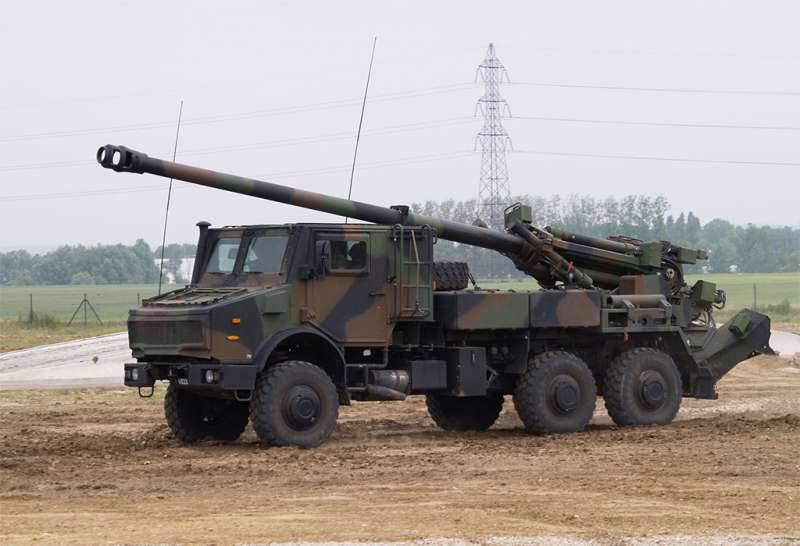
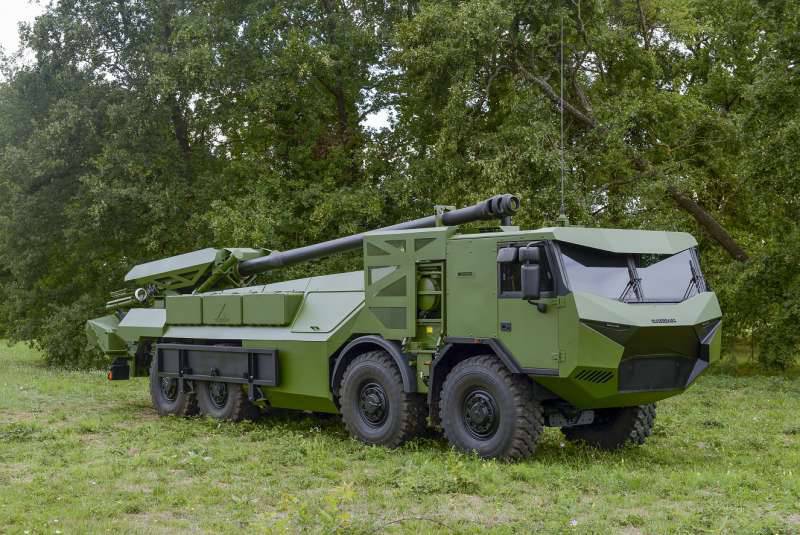
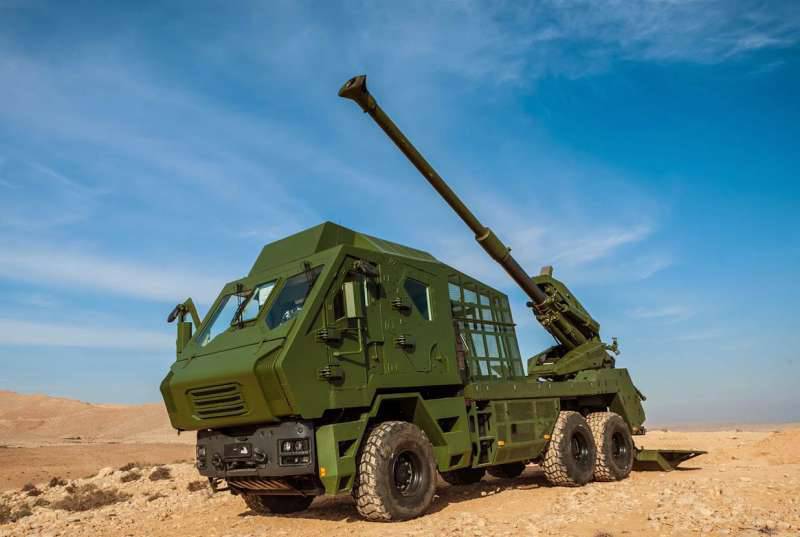
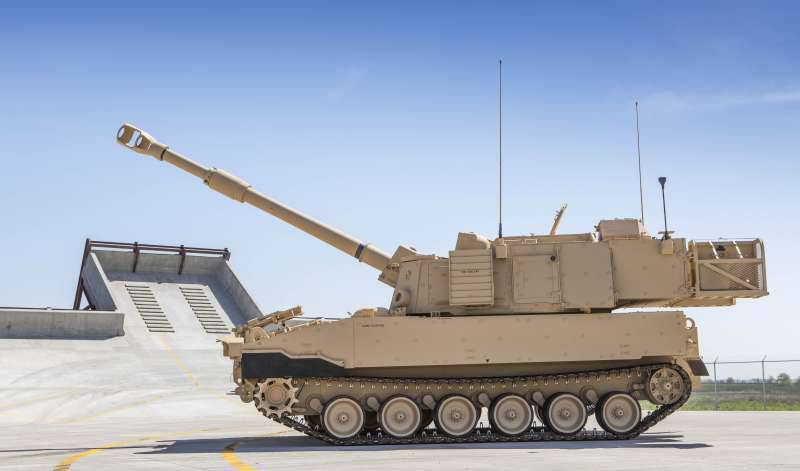
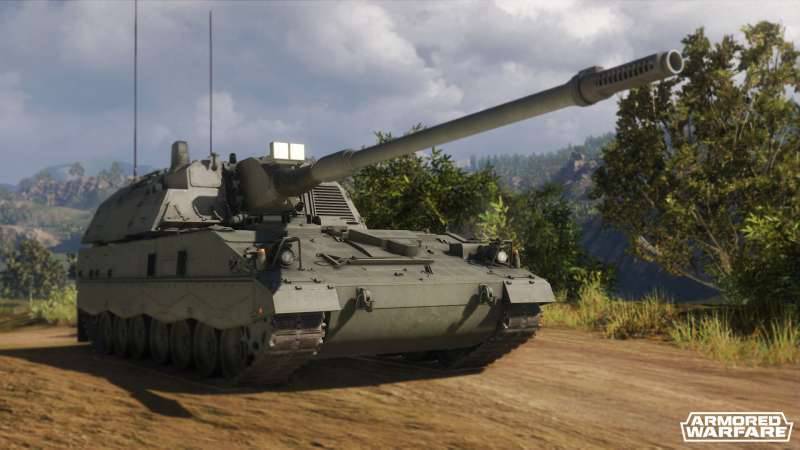
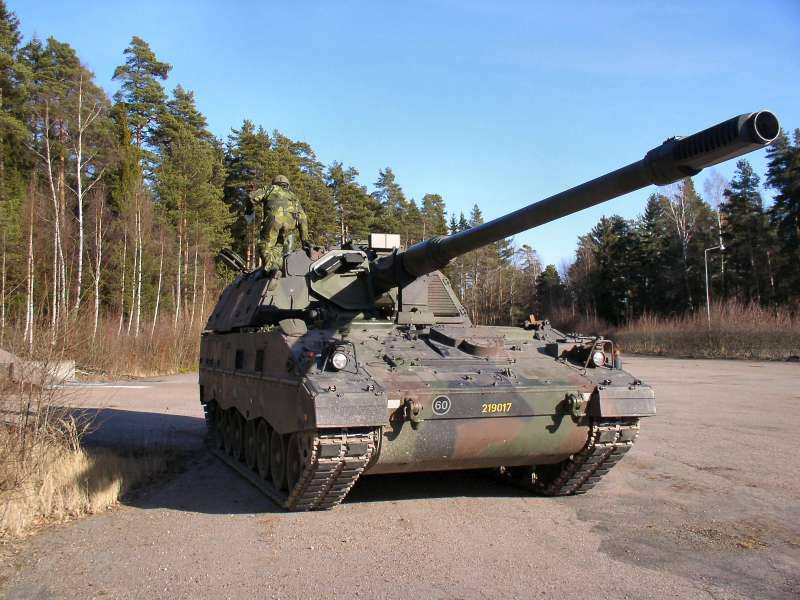
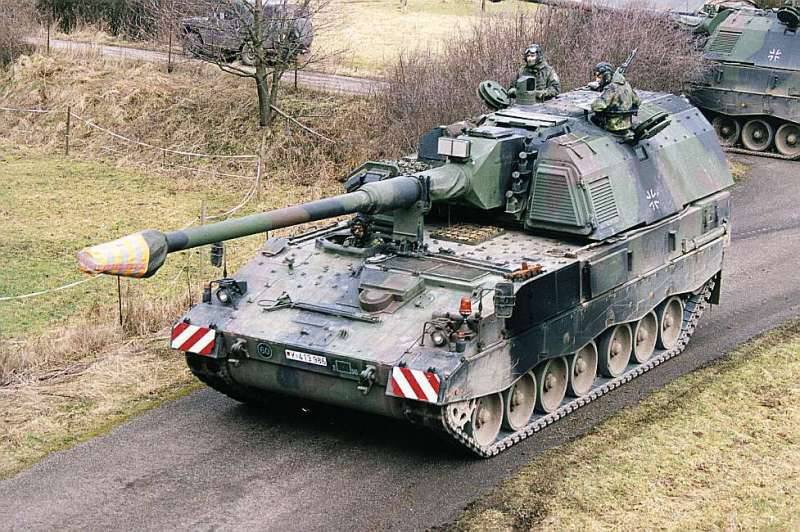
Information